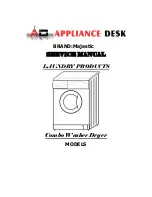
7
RAPTOR MANUAL - HIGH PRESSURE CLEANER
4. Inspect the pressure cleaner nozzle orifices for any
damage or blockage. Blockages can be cleaned with
a nozzle cleaning tool. Use care not to enlarge nozzle
orifices while cleaning. Damaged nozzles or nozzles
with enlarged orifices can decrease unit performance
and should be replaced.
5. Inspect the hoses, connectors and fittings for wear and
damage. If there are any kinks, cracks, breaks or wear
through the outer jacket of the hose or other damage,
do not use the hose. Damaged hoses can burst or
leak high pressure water and cause serious injury.
Replacement hoses and fitting should be rated at or
higher than the unit pressure rating.
6. Inspect and maintain the engine per the engine
operator’s manual.
7. Check engine fuel level. If needed, add unleaded
gasoline. See engine operator’s manual for
requirements. Use caution when handling gasoline.
Work in a well ventilated area. Never fill the tank while
unit is running, do not overfill tank and do not spill fuel.
Make sure tank cap is securely closed.
8. Check the oil level(s) in the pump through the
sight glass and add oil if needed (see Maintenance
Instructions section). Inspect Engine as directed in the
engine operator’s manual.
Machine and Work Area Set-up
Always wear safety glasses, gloves and other
appropriate protective equipment when setting up
your pressure cleaner. Rubber soled, non-slip shoes
can help prevent slipping on wet surfaces.
Engines produce carbon monoxide, a colorless,
odorless poison gas. Breathing carbon monoxide
can cause nausea, fainting or death. Do not start and
run engine in an enclosed area, even if doors and
windows are open. Only operate outside.
Set-up the unit and work area according to these
procedures to reduce the risk of injury from high
pressure water, chemical burns, infections, carbon
monoxide and other causes, and prevent jetter
damage.
1. Check work area for:
• Adequate lighting.
• Flammable liquids, vapors or dust that may ignite.
If present, do not work in area until sources have
been identified and corrected. The machine is not
explosion proof and can cause sparks.
• Clear, level, stable dry place for machine and
operator.
• If needed, remove the water from the work area.
Wood or other coverings may need to be put
down.
• Unit location that is in a well ventilated outdoor
area. Do not place the jetter indoors, even with
doors and windows open. Unit can be located
remotely from the point of use.
• Suitable water supply. Clear path to transport the
unit to the set up location.
2. Inspect the surface to be cleaned, and make sure no
materials or elements are in the way of the unit.
3. Determine the correct equipment for the application.
4. Make sure all equipment has been properly inspected.
5. Evaluate the work area and determine if any barriers
are needed to keep bystanders away. Bystanders
can distract the operator. If working near traffic, erect
cones, signs or other barriers to alert drivers.
6. Take the unit to the well-ventilated outdoor work area
along the clear path. See Transportation Section.
Be aware of possible slip hazards. Wear appropriate
footwear to help prevent slips.
WARNING
Figure.5 - Raptor Water Filter
Содержание Raptor
Страница 14: ...14 RAPTOR MANUAL HIGH PRESSURE CLEANER Notes ...
Страница 15: ......


































